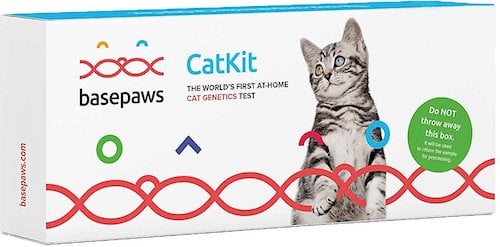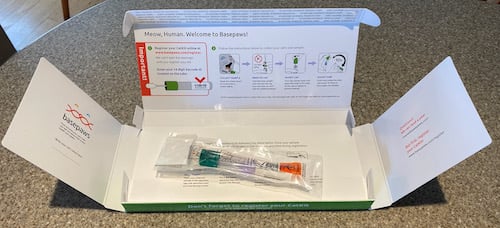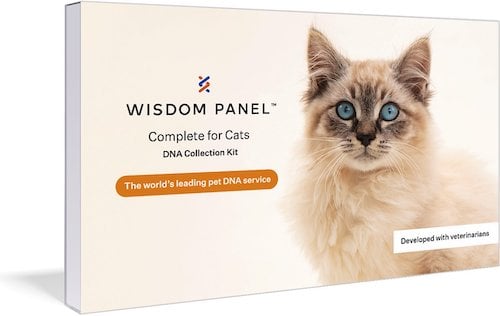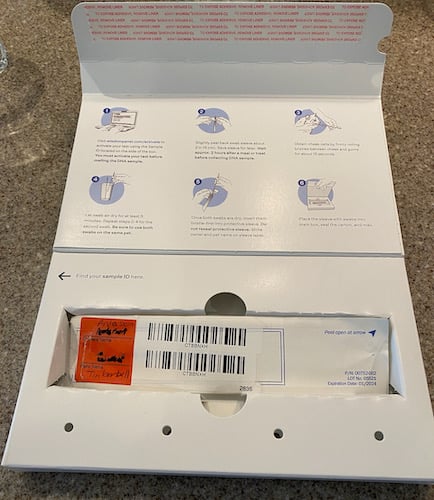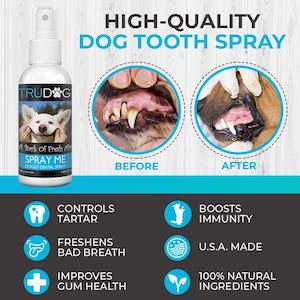- This post contains affiliate links. Read more here.
- Not a substitute for professional veterinary help.
Based on the way she looks and acts, everyone assumes that Tinkerbell, our bobtailed dilute calico, is a Japanese Bobtail. And it may be a stretch, but we think our incredibly affectionate, domineering black cat, Toby, might be part Bombay. Are we on the mark, or is this just wishful thinking about the genetics of our two amazing and adored kitties? We turned to a cat DNA test to find out.
We ordered cat DNA test kits from the two leading pet DNA analysis companies, Basepaws and Wisdom Panel. After registering our cats on the companies’ websites, we collected DNA samples at home (a process described in detail, below) and mailed them in for analysis. Then we settled back to wait for the exciting revelations about Toby and Tinkerbell’s ancestries, traits, and gene-linked health risks.
During the wait, we studied the information on cat DNA tests prepared for Rover in 2019 by Emilie Bess, a DNA scientist with a degree in molecular evolution. Bess wrote the original version of this article that we’re now updating with actual test analysis from my two cats.
iSock via Patricia Gee
A Quick Explanation of Breeds and Genetics
Bess’ explanations did a lot to temper our expectations about what a cat DNA test could—and couldn’t—tell us about Tinkerbell and Toby. It turns out that DNA testing reveals far less about cat breeds than it does about dog breeds. (Find out about dog DNA tests here.) This is because of the different ways that cats and dogs were domesticated.
“Dogs were the first animals to be domesticated by humans, somewhere between 14,000-40,000 years ago. Cat started hanging around with people only about 8,000 years ago, and their domestication process was much more gradual,” says Bess.
“We actively domesticated dogs,” Bess continues. “Cats…not so much. Dogs were selected for their ability to perform specific tasks, such as guarding, shepherding, and companionship. Selective breeding for the physical and personality traits led to the development of dog breeds, which began very early in the relationship between humans and dogs, more than 10,000 years ago.”
This means that dog breeds are genetically distinct. In DNA terms, a Chihuahua and a Golden Lab are very different from one another. (For more information, here are some recent studies on the genetics of dog breeds.)
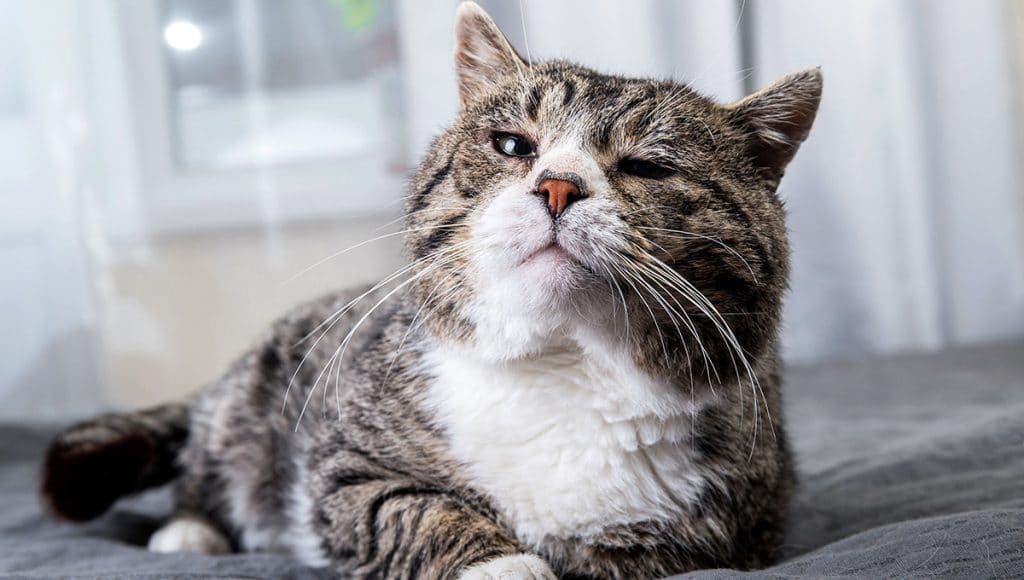
Aleksandr Zotov/iStock
While dogs were being deliberately bred for particular traits, cats pretty much domesticated themselves. There is evidence that breeding for tabby markings began in the 18th century, but the development of distinct cat breeds that have specific physical and personality traits didn’t get seriously underway until about 150 years ago when breeds like Abyssinian, Persian, and Maine Coon were developed (today there are 45 cat breeds recognized by the Cat Fanciers Association).
Some rare breeds have been around for less than 50 years. That’s not long enough for genetically robust differences to exist.
This means that even two cats that look as different as a Silver Tabby and a Norwegian Forest cat are genetically pretty similar.
“90% of domestic cats have no purebred bloodline at all,” they look and act just as their ancient ancestors did, and they share nearly identical genetics,” Bess says.

iStock via GluePromsiri
Interpreting Cat DNA Test Results
While a cat DNA test may not tell you much about your cat’s breed, you will find out quite a bit about where your cat’s ancestors came from.
Modern domestic cats originated from Egyptian cats (similar to today’s Egyptian Mau) and spread throughout Europe, Asia, Africa, and the Americas. Genetic markers have shown that cats are differentiated into distinct groups in these four regions: the Mediterranean basin, Europe/America, Asia, and Africa. Cat DNA test results will tell you which of these groups your cat is descended from.
Some cat DNA tests provide results that indicate if your cat has a “marker” for a certain health risk. Of this, Bess is skeptical. She says not to worry if a test says your cat has a marker for a particular disease. It does not mean your cat has the disease, or that your cat is going to get the disease.
Researchers writing in the journal Nature point out that “most of these [pet DNA] tests are based on small, underpowered studies. Neither their accuracy nor their ability to predict health outcomes has been validated. Most vets don’t know enough about the limitations of the studies, or about genetics in general, to be able to advise worried owners.”
So, while you’re likely to learn more about your cat’s genes than you currently know, the information you receive is unlikely to be conclusive.
How Cat DNA Test Kits Work
DNA kits allow you to collect a sample of your cat’s saliva or cheek cells to be mailed to the company for analysis. Depending on your cat’s personality, this can be a breeze…or a bit of an adventure. We took samples from each cat with tests from two companies, Basepaws and Wisdom Panel.
Both kits arrived in the mail with the directions and equipment you need to collect the samples. Note: Be sure to save those boxes, because you’ll be using them to ship the samples back.
Once you open the box, go to the company’s website to register your cat and the numbered test kit. Now you’re ready to take the actual sample from your cat.
Collecting DNA Samples From Your Cat
The Basepaws box comes with instructions printed on the box itself. They were straightforward and easy to follow.
The box contained a swab, much like a big sturdy Q-tip, and a tiny plastic test tube filled with a liquid for shipping the swab with your cat’s saliva sample. You insert the swab into your cat’s mouth, in the cheek pouch, for five seconds. Then insert the swab into the test tube, close the test tube, and ship it back to Basepaws.
Both Tink and Toby submitted to being swabbed with only minor annoyance. So, a “paws up” all around! We shipped the kits and sat back to wait for our results.
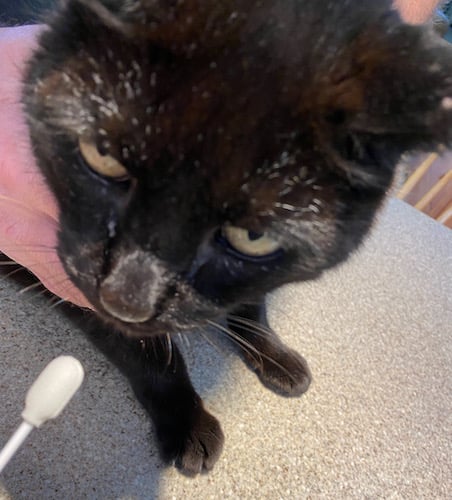
Toby gets tested with a Basepaws swab
The Wisdom Panel box also comes with easy-to-read, step-by-step, instructions. We visited the website to register the cats and the kits. Then, things got complicated.
Instead of swabbing inside the mouth for 5 seconds for saliva (as we did for Basepaws), you swab the inside of the cat’s cheek pouch for 15 seconds with a tiny plastic comb designed to collect cells. (This is known as a buccal swab.) Then you swab the inside of the cat’s cheek pouch for another 15 seconds, with a second comb.
You let the combs dry for 5 minutes (in a glass or other container that you provide). The dry samples go into the included sample envelope that you ship in the box back to Wisdom Panel.
On one hand, it seems likely that the cheek cells provide a really robust DNA sample, less likely to be contaminated by cat food than the saliva we sent to Basepaws. On the other hand, it was tough to get Tinkerbell to put up with 15 seconds of cheek swabbing, and even more difficult to get her to submit to a second round of cheek swabbing. The Wisdom Panel sampling is definitely a two-person operation! Tom held Tinkerbell while she struggled violently and I swabbed.
I swear that Toby did not witness any of Tink’s experiences. Nevertheless, he refused to let us conduct even the first round of cheek swabbing for the Wisdom Panel. Despite being 24 years old, Toby has all of his teeth, and he made it clear that he was ready to use them. So we called our veterinarian and made an appointment to have a technician collect Toby’s samples.
Tip: If you decide to use Wisdom Panel (which we liked quite a bit) it may make sense to wait for your cat’s annual checkup and ask your vet’s team to collect the DNA samples. Our vet techs seemed very familiar with the procedure.
Wait Time
Basepaws let us know when our samples had been received, when they were being analyzed, and when the test results were ready to view on their site (about four weeks after we’d mailed in the samples). Wisdom Panel let us know when the samples were received and when the results were ready to view (about two weeks after we’d mailed in the samples).
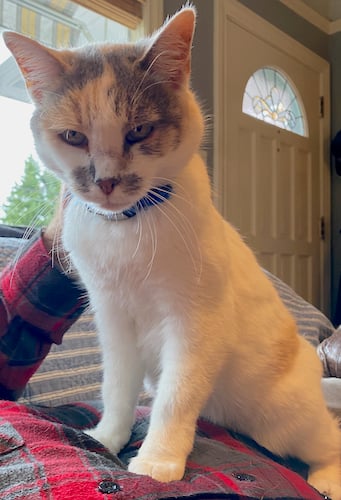
Tinkerbell. Is she a Japanese Bobtail?
What We Found Out About Our Cats’ DNA and Health
Keep in mind that the DNA tests we purchased look only at genes associated with cat breed, some physical traits, and elevated risk of some relatively rare health conditions. (You can buy a more expensive test from Basepaws that does more extensive genome sequencing.)
That said, we found our cats’ results to be interesting. And there were certainly some differences in the way the two companies presented our cats’ data.
Tinkerbell’s Results
Let’s start by looking at Tinkerbell’s results. With dilute calico markings and a bobtail, was she a Japanese Bobtail?
Answer from both Basepaws and Wisdom Panel: Unlikely.
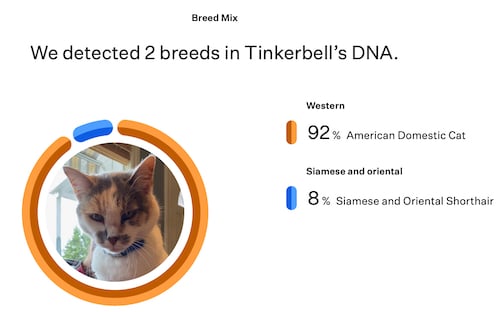
Wisdom Panel breed analysis

Basepaws breed analyses (possible vs. confident)
While Tinkerbell is not a Japanese Bobtail, some of her ancestors may have been, given that some of her geographic ancestries is Asian (also called Eastern or Siamese/Oriental).
While Basepaws didn’t have anything to say about Tinkerbell’s bobtail, Wisdom Panel did.
The Wisdom Panel traits data also confirmed that her cute little short tail is a genetic trait. However, when we did a deeper dive into the results, we can see that her short tail genes are commonly associated with Manx rather than Japanese Bobtail cats. OK, Tinkerbell: You’re from the Manx family.
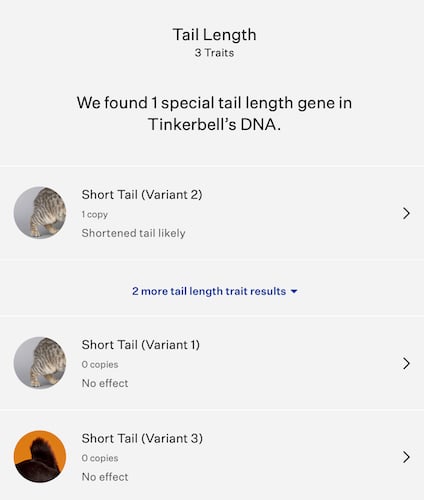
Wisdom panel traits analysis (bobtail)
While we got more data from Wisdom Panel, we really liked the way that Basepaws displayed the breed analysis information. You can select the level of certainty you want to view, ranging from “maybe” and “possible” to “likely” and “confident” (see our screenshot, above, for the differences in Tinkerbell’s results).

Toby. Is he a Bombay?
Toby’s Results
Let’s take a look at Toby’s results. Is our super-friendly buddy with a short black coat and big gold eyes related to Bombays?
Answer from Basepaws and Wisdom Panel: Unlikely.

Wisdom Panel breeds analysis
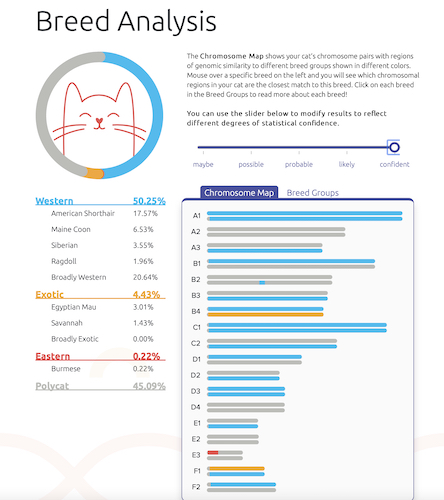
Basepaws breed analysis
Yes, Toby is your basic Western cat (according to Wisdom Panel) or your basic Western and “polycat” (according to Basepaws). But—wait a minute! What on earth is a “LaPerm?” Wisdom Panel’s Breed Explorer Feature let us find out about this fascinating breed of small, people-oriented, curly-haired cats that originated in Oregon in 1982. While Toby is not a LaPerm, he does share some ancestors with them.
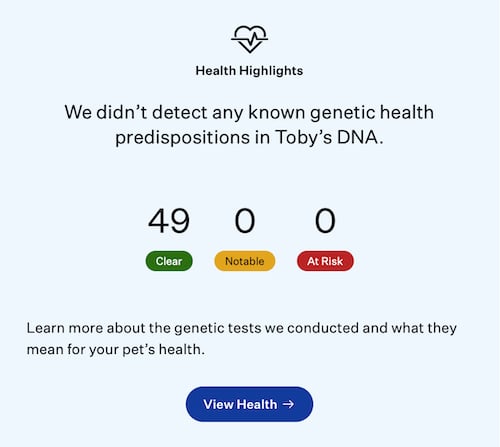
Wisdom Panel health results
Both Wisdom Panel and Basepaws looked at our cats’ DNA to see if our cats are genetically disposed to a higher risk of certain health conditions for which they have comparative data. The answer, for both cats, was no elevated risks. So I can’t say much about that part of the DNA testing.
So, Should You Try a Cat DNA Test?
Bess concludes, “At this point, cat DNA tests are marketed as a novelty and intended to satisfy curiosity about the origins of our pets. You’ll get some cool info about where on earth your cat’s ancestors lived, and you might even get some information on your cat’s health. You’ll be joining a growing community of cat lovers who are contributing to the understanding of cat genetics. Depending on what service you use, you might get future updates that give you more information as their database expands and improves.”
For our part actually testing these kits on my cats, we were pleased with both tests.
We liked Wisdom Panel’s detailed examination of gene-linked traits, such as Tinkerbell’s bobtail. But we preferred Basepaws’ easy, 5-second saliva test to Wisdom’s Panel’s more complex, two-swab collection methods.
Two other Cat DNA tests are available that we did not try. They are:
- Neogen’s Cat DNA test, designed for breeders and people interested in parentage and health information for purebred cats
- Orivet Cat DNA Test Kit, focusing on health issues rather than breed information (in fact, it requires you “know the breeds that make up your cat” before you order the test)
We have to admit, we enjoyed seeing the results of the Wisdom Panel and Basepaws. So much so, that we’ve ordered another test for Max, the neighborhood cat we adopted.
Is Max truly a Siberian with a triple-layer coat?
We don’t think he cares.
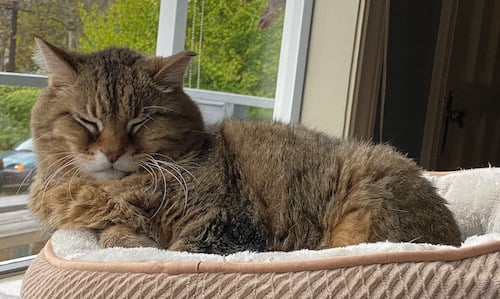
Max. Could he be a Siberian?
Basepaws Breed + Health DNA
Wisdom Panel Complete
This post was originally written by Emilie Bess.


